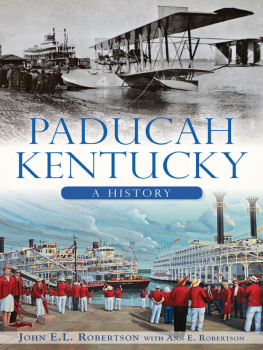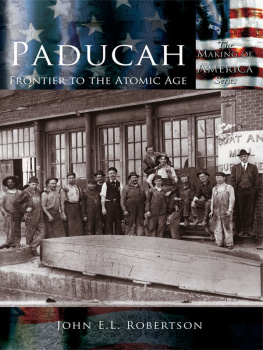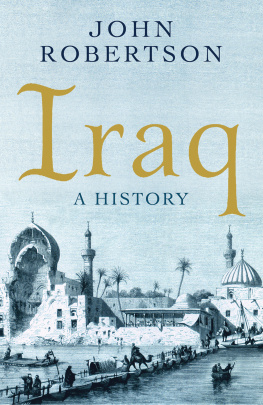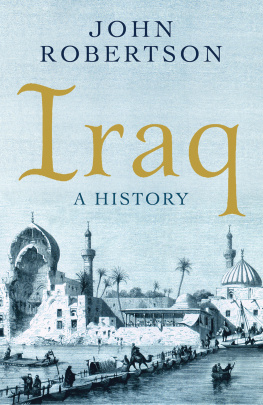
Paducah city map.

Published by The History Press
Charleston, SC 29403
www.historypress.net
Copyright 2014 by John E.L. Robertson
All rights reserved
Front cover, lower image: Robert Dafford floodwall mural, used with the consent of Dafford Murals.
First published 2014
e-book edition 2014
ISBN 978.1.62585.068.3
Library of Congress Cataloging-in-Publication Data
Robertson, John E. L.
Paducah, Kentucky : a history / John E.L. Robertson ; with Ann E. Robertson.
pages cm
Includes bibliographical references and index.
print edition ISBN 978-1-62619-532-5
1. Paducah (Ky.)--History. I. Robertson, Ann E. II. Title.
F459.P12R62 2014
976.995--dc23
2014012335
Notice: The information in this book is true and complete to the best of our knowledge. It is offered without guarantee on the part of the author or The History Press. The author and The History Press disclaim all liability in connection with the use of this book.
All rights reserved. No part of this book may be reproduced or transmitted in any form whatsoever without prior written permission from the publisher except in the case of brief quotations embodied in critical articles and reviews.
CONTENTS
PREFACE
There are two Paducahs: one in Kentucky and one in Texas. In Kentucky, an elaborate myth has grown over time concerning the origin of the name. According to one of the more common variants, Chief Paduke was a Chickasaw who owned the land at the mouth of the Tennessee River and returned to the site after it had been ceded to the whites under the Clark claim. According to this version, the old Indian died and was buried here by his grieving followers. So noble and distinguished was this savage that William Clark decided to rename the village of Pekin in honor of the chief.
A statue of the legendary Chief Paduke was commissioned by the Daughters of the American Revolution in 1909. Lorenzo Taft was the artist who made the carving, and he got to thinking about the Indian and wanted to know more about him; therefore, Taft wrote to some of the leading authorities of the time, inquiring about Paduke. Taft became convinced that the whole story was a fabrication and reported as much to Chicago newspapers. Word of Tafts revelation reached Paducah, and a wave of misguided public sentiment caused many to rise in defense of the citys symbol, including Irvin S. Cobb.
By the time of homecoming in 1913, Chief Paduke was officially declared to be a person by Paducahans. In fact, James Wheeler portrayed the legendary chief in the celebration; he arrived by river, rode up Broadway and received the official welcome of Mayor Thomas Needham Hazelip. In connection with the controversy, it is interesting to note that the Paducah newspapers carried a picture of Chief Padukea feat quite remarkable since Paduke was reported to have died in 1818, before photography was conceived. Bumptious behavior of Paducahans continued to add to the legend. From where, then, did the name of the city derive?

William Clark bust.

Robert Dafford mural showing (left to right) William Clark and George Rogers Clarks arrival at the site of Paducah.

Statue of legendary Chief Paduke by Loredo Taff.
There are two other equally well-known legends of Paducah. Edmund Flagg, in The Far West, records the story of a captive Indian woman who was sacrificed by a band of Pawnees after having been assured of her safety. At least the Skidi Pawnee have a legend of having lived in the Ohio Valley at one time; perhaps the two traditions became intermingled. The other story seems to have been the origin of the name given to the Kentucky community.
In Letters of the Lewis and Clark Expedition with Related Documents, 17831854, edited by Donald Jackson, there are numerous references to the Padouca tribe of Indians. James McKay considered the name Paduca synonymous with Madoc, a Welsh prince, and William Clark knew of McKays map;
In 1827, Clark wrote to his son M.L. Clark, a cadet at West Point, that he was on his way to the mouth of the Tennessee River to lay out a town named Paducah to honor the memory of a proud people who had been decimated by contact with European civilization.
Chapter 1
PADUCAH
In 1884, Robert S. Davis, who came to Paducah from Harrison County, Kentucky, in 1821, was interviewed. Davis recounted that the first house at the Paducah location was claimed by more than one party, and the title of William Clark was also questioned in the courts.
George Rogers Clark claimed the site of Paducah under a Virginia Treasury warrant dated September 15, 1795. Clark died in 1818, and it remained for his brother William, of Lewis and Clark fame, to develop the site. William Clark had the location platted on June 18, 1830.
In 1827, the court at Louisville appointed Samuel Dickinson commissioner to carry out the sale of the Clark lands in western Kentucky. The record shows that William Clark purchased the site of Paducah. This was later found to have given a defective title, so the court corrected the record to show that the land was purchased by George Woolfolk of Shelbyville, Kentucky. The heirs of George Rogers Clark were instructed to deed the land to Woolfolk, and if they failed to do so, Samuel Dickinson, as commissioner, was ordered to do it for them. The heirs did nothing; Dickinson acted on June 16, 1827. Woolfolk later sold the land to William Clark on October 13, 1827, for the sum of five dollars in hand paid. Woolfolk seems to have acted in this matter as the agent of William Clark, a role that he would later play at Paducah. Finally, Clarks title was clean. Settlement could start.
The first election for trustees for Paducah was held on May 2, 1831, at the home of George Dunn. At the meeting of this first board three days later, F.A. Harrison was made chairman. Thomas J. Flournoy, George Dunn, Robert Enders and Dr. Robert Fletcher, the trustees, made Ruben Laughlin clerk and assessor, while James C. Calhoun became collector and Valentine Owen was selected the first overseer of streets. The first business included orders to remove fences standing across some public avenues and to prevent keelboats from landing in front of the town. The question of the city waterfront was to occupy the city leaders on many future occasions, as the presence of keelboats, broad horns, flat boats, rafts and, later, steamboats was to be both a source of revenue and a menace to the health of the community.

Lewis and Clark memorial by George Lundeen on the grounds of MAQS.
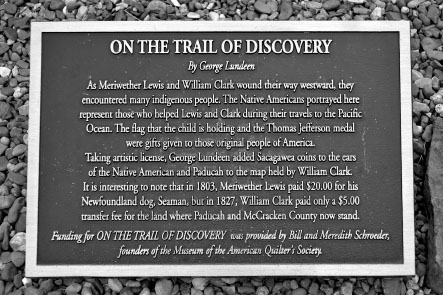
Plaque for Lundeens Lewis and Clark statues.
All towns perform a service. Paducah developed as the center of commerce for the region. The vitality of the community, its organization and its growth depended on the towns role as the center of distribution of goods and services to the surrounding hinterland. Located as Paducah was on two major waterways, river trade was of prime importance to the growth of the town. In a short time, Paducah was a break-in-bulk point for much of the traffic on the lower Ohio River.
Next page
